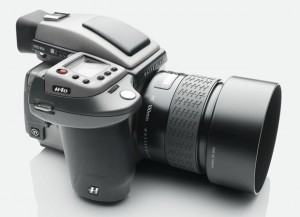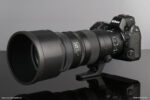Why Full Frame Equivalency Doesn’t Matter
Now, after that longwinded explanation of all this equivalency stuff…does it matter? What effect does it have on your photography? In my opinion,if you’ve selected your camera format based on your preferences, full frame equivalency doesn’t matter one iota.
Full Frame is not a Magical Reference Format

The biggest issue I have with all the equivalency talk is that it treats the 35mm size as some sort of magical reference format where lenses act their ‘true’ self. This is flat out not the case, and it comes mainly from the introduction of the ‘crop factor’ to help out 35mm photographers who transitioned to digital when APS-C was pretty much all there was. Before 35mm became popular, most photographers shot with a larger format. 35mm was the ‘mini’ format of its day. Ansel Adams predominantly used 8×10 and 4×5 view cameras, with a film size many, many times that of 35mm. In fact, if people used ‘crop factors’ back in that day, they would consider 4×5 to be a 2x crop factor of 8×10 and 35mm to have a crop factor of 7.5x!
While there certainly was some snobbery about the size of 35mm film vs a large format or medium format film, the size differences there are many times what we are talking about between full frame and smaller format interchangeable lens cameras of today. The ‘normal’ lens on 645 medium format camera is 75mm. On 35mm it’s 50mm, on APS-C it’s 30-35mm, and on 4/3 it’s 25mm. Why don’t we make 645 medium format the ‘reference’. Then ‘full frame’ would have a crop factor too? The whole point is, the use of 35mm as the ‘master format’ is arbitrary, and the use of crop factors to denote equivalent lenses is a modern invention that has little use except to help jog the memories of those used to one format and transitioning to another.
If you don’t have tons of experience and mental ‘feel’ for what a specific focal length or aperture acts like on 35mm, forget the crop factor ENTIRELY. It is of absolutely ZERO use to you. Why reference a format of camera that you aren’t using?
Full Frame Advantages
Now, before I tell you why worrying about ‘equivalence’ is irrelevant, you need to first understand that I am not saying that full frame cameras don’t have some very real advantages over smaller format cameras. They do, but only ONE of them relates to aperture. Full frame cameras have the following advantages over smaller format DSLRs and Compact System Cameras (CSCs):
- Lower Noise. Full frame cameras of similar sensor technology to their smaller counterparts will yield lower noise images at its baseline, and continuing throughout the range. Generally, it’s about half to one stop advantage over APS-C and about 1-2/3 stop advantage over 4/3.
- Richer tonality. Full frame cameras generally have higher color bit depth and therefore a little richer tonality and colors. This can give them a somewhat intangible look that gives that little extra something to an image.
- The ability for shallower depth of field and extremely blurred backgrounds. While you can certainly acheive plenty of background separation and shallow depth of field with APS-C and 4/3 sized sensors, you aren’t going to match the ability of a full frame camera with a hyper fast lens like an 85mm f/1.2 or a 300mm f/2.8 to obliterate the background.
And, that’s pretty much it. It used to be that you could add Dynamic Range (the ability to capture a wider range of shadows and highlights in a single image) to the list above, but in recent times, this isn’t the case. While a full frame sensor of the same sensor technology will still generally have a little better dynamic range, this has much more to do with the individual sensor than the size any more. For instance, the Olympus OM-D E-M5 has better dynamic range than ANY Canon DSLR ever made, while the APS-C Nikon D5200 is within 1/3 stop of matching the dynamic range of the Nikon D600.
The Fallacy of Aperture Equivalence
While crop factor has a use simply to compare focal lengths between formats and such, the constant comparison of a smaller format lens to its full frame ‘equivalent’ aperture is largely unevenly applied and misunderstood. It’s often used to show that a smaller format is inferior or not capable of the same things as a larger format. In some cases, this usage is correct, but it is also nearly never used the other way.
I’ve heard many times “Yeah, your 75mm f/1.8 is crap – it’s like a 150mm f/3.6.” No, it’s not, it’s a 75mm lens with an f/1.8 aperture and a field of view that is the same as a 150mm lens on full frame.
What IS true is that the 75mm f/1.8 is not capable of the same ultra shallow depth of field as, say, something like the Sony Zeiss 135mm f/1.8 on full frame. However, this is essentially the ONLY way that it is inferior. It passes the same amount of light, and it exposes as an f/1.8 lens because it IS an f/1.8 lens. If I’ve chosen a smaller format system, I’m already OK with the fact that it doesn’t equal a full frame camera in the noise department, so there is no ‘aperture advantage’ after the fact. Those who harp on aperture equivalence as it relates to shallow depth of field also IGNORE all the BENEFITS to having more depth of field for the same aperture:
- Times you WANT a little more depth of field than your lens can provide wide open. (portraits where you want more than one eyelash in focus; indoor travel photos like shooting inside a cathedral, etc). Often these situations are situations where a tripod is not allowed or not practical.
- Studio work, where apertures are typically f/8 to f/11 for full frame users to get a person’s face completely in focus. With the smaller format, you can use strobes at 1/4 the power as the full frame user can, allowing for flashguns instead of studio strobes, or faster recycle for the same strobes.
- Landscape photography when it’s windy, or you’re trying to stop motion – being able to shoot at f/8 rather than f/16 can be quite helpful.
- Macro photography, where inherently deeper depth of field is most desirable, especially when lighting is problematic.
These situations make up a LOT of shooting. Now, when light is limited in any way, these advantages come up. Now, sure, you can up the ISO two stops on the full frame camera to compensate (or 1-1/3 stops when comparing to APS-C), but now, the full frame camera has just lost ALL of its image quality advantages, and you’re still stuck carrying the larger and more expensive gear.
When do you need to stop down indoors? Group shots, any time you want to get two people at different depths in the image in focus, indoor architecture shooting when traveling (most European cathedrals won’t let you use a tripod), etc.
Most advanced photographers using a smaller format understand the tradeoffs
Here’s the big one. If you have chosen a smaller sensor camera, and are an advanced enough photographer to have mastered the relationship between aperture and focal length and such, and own several lenses and such, then you’ve made that choice understanding the tradeoffs, and ‘equivalence’ talk is useless. It’d be the same if every full frame photographer heard that their 24mm f/1.4 was really ‘only’ equivalent to a 180mm f/11 on an 8×10 view camera. Yes, that would be the ‘equivalent’ lens in focal length and aperture for the same depth of field, but who cares? It’s irrelevant to the discussion on the camera the person is actually using. Just like a 35mm format photographer has made the tradeoffs from large or medium format for a more responsive, smaller kit, so too have APS-C and 4/3 format photographers made the choice to forgo a little noise performance and some ability to shoot at ultra shallow depth of field in exchange for smaller size or more affordability.
Given that my lenses give me shallow enough depth of field for most anything I could ever want, and image quality is absolutely good enough for most any size print I make, I simply get to save 12 lbs of gear in my bag for the same apertures and field of view. I shot with APS-C DSLRs for four years before moving to full frame in 2009. I shot with a full frame Canon kit with a bag full of L lenses, so I know what a top flight full frame kit can do. I’ve made my decision that portability and light weight are more important to me as a photographer than the ability to do sliver thin depth of field. In fact, I think my photos from the past two years are far BETTER than those I got with my full frame kit, simply because I enjoy shooting more and I take a lot more photos as a result.
So, those of you who keep hammering on this ‘equivalence talk’, please stop. We’ve already made the decision to forgo extremely shallow depth of field by our choice of cameras. The aperture equivalence talk when harping on crop lenses is only relevant if you are somehow trying to gain back full frame levels of shallow depth of field, or you are somehow trying to get another system to exactly match the output of a full frame system, which is a fools errand. The formats are not equivalent. Why should discussions of lenses be framed in a way that assumes they should be?





Leave a Reply